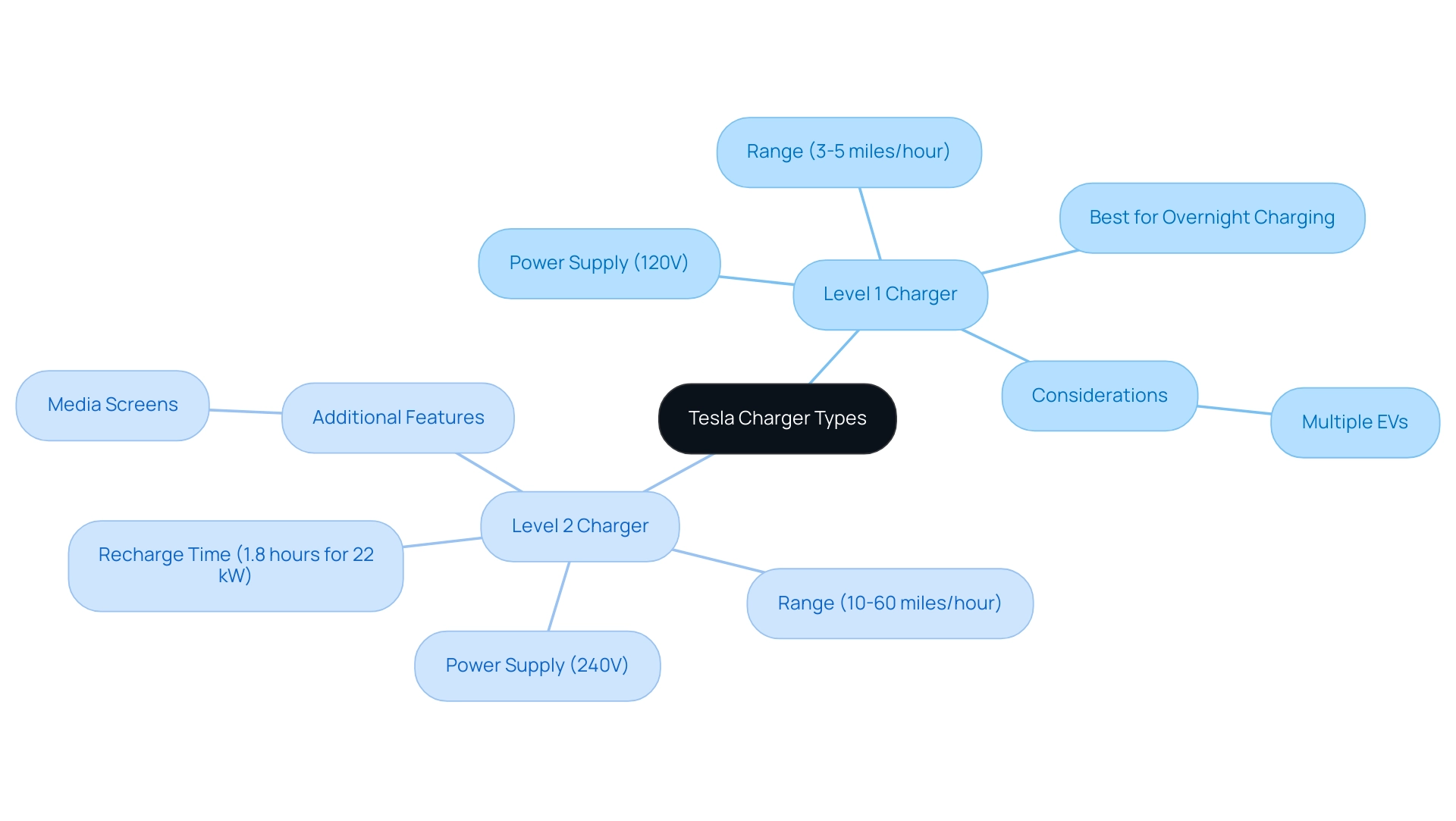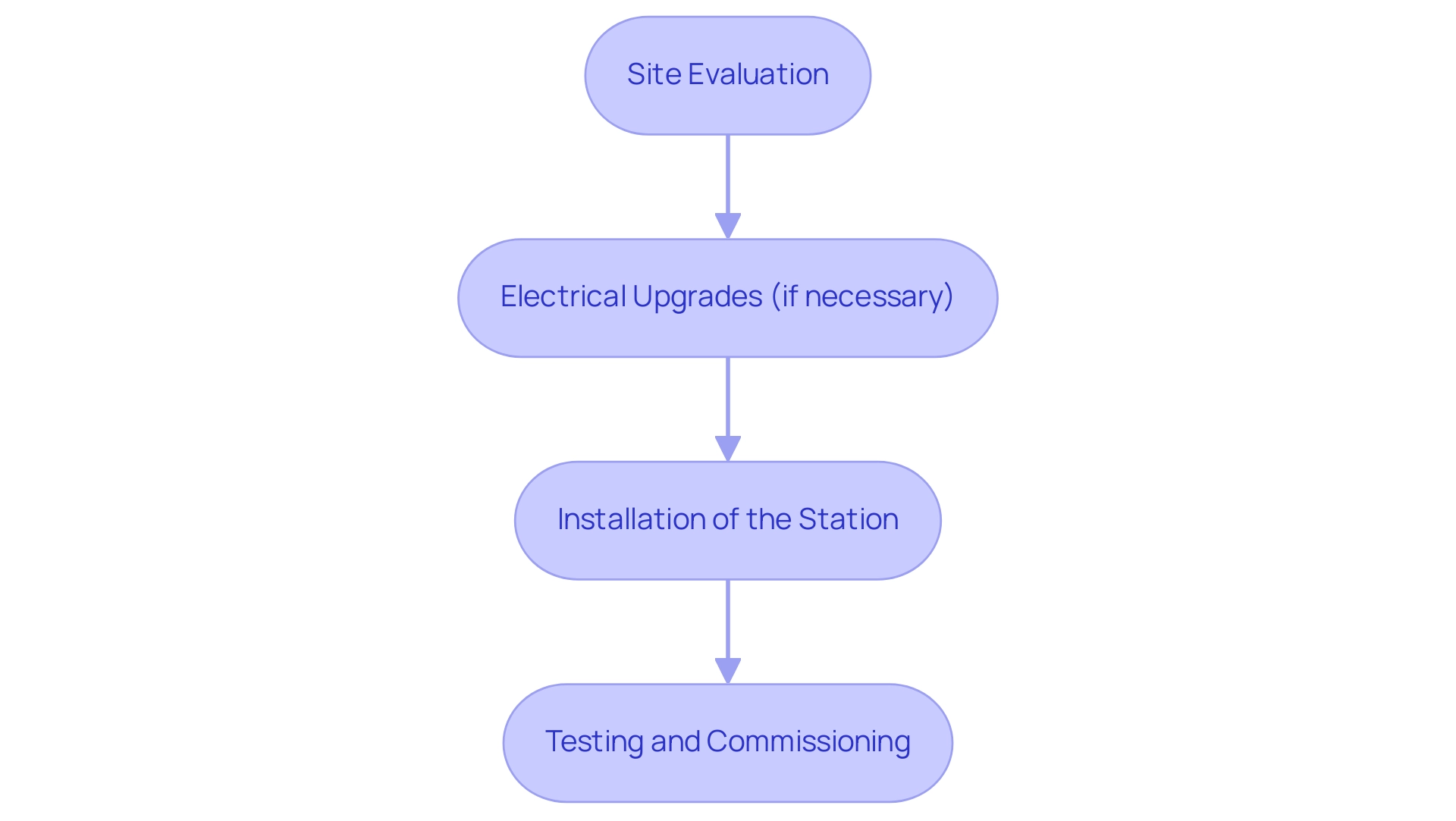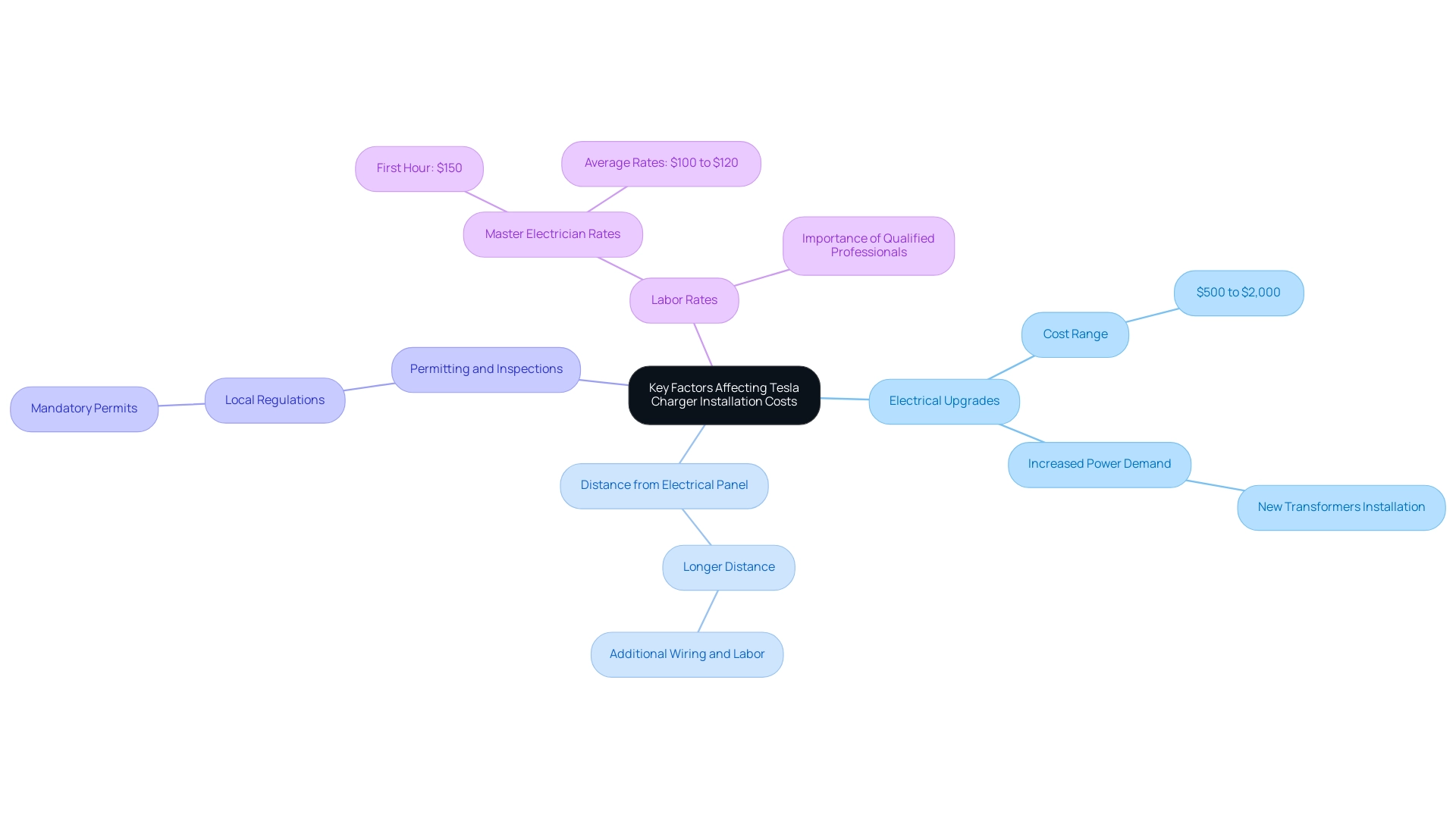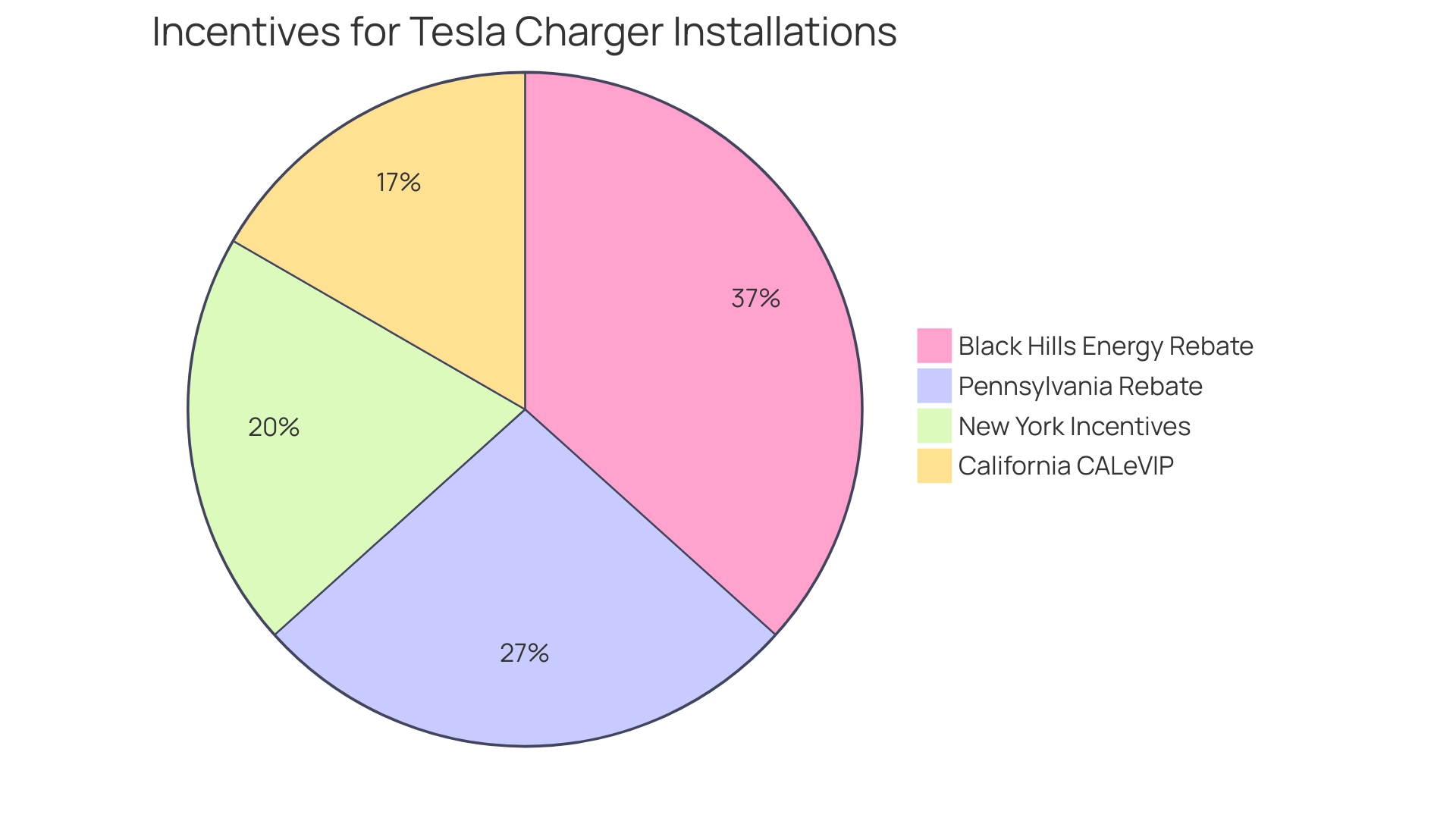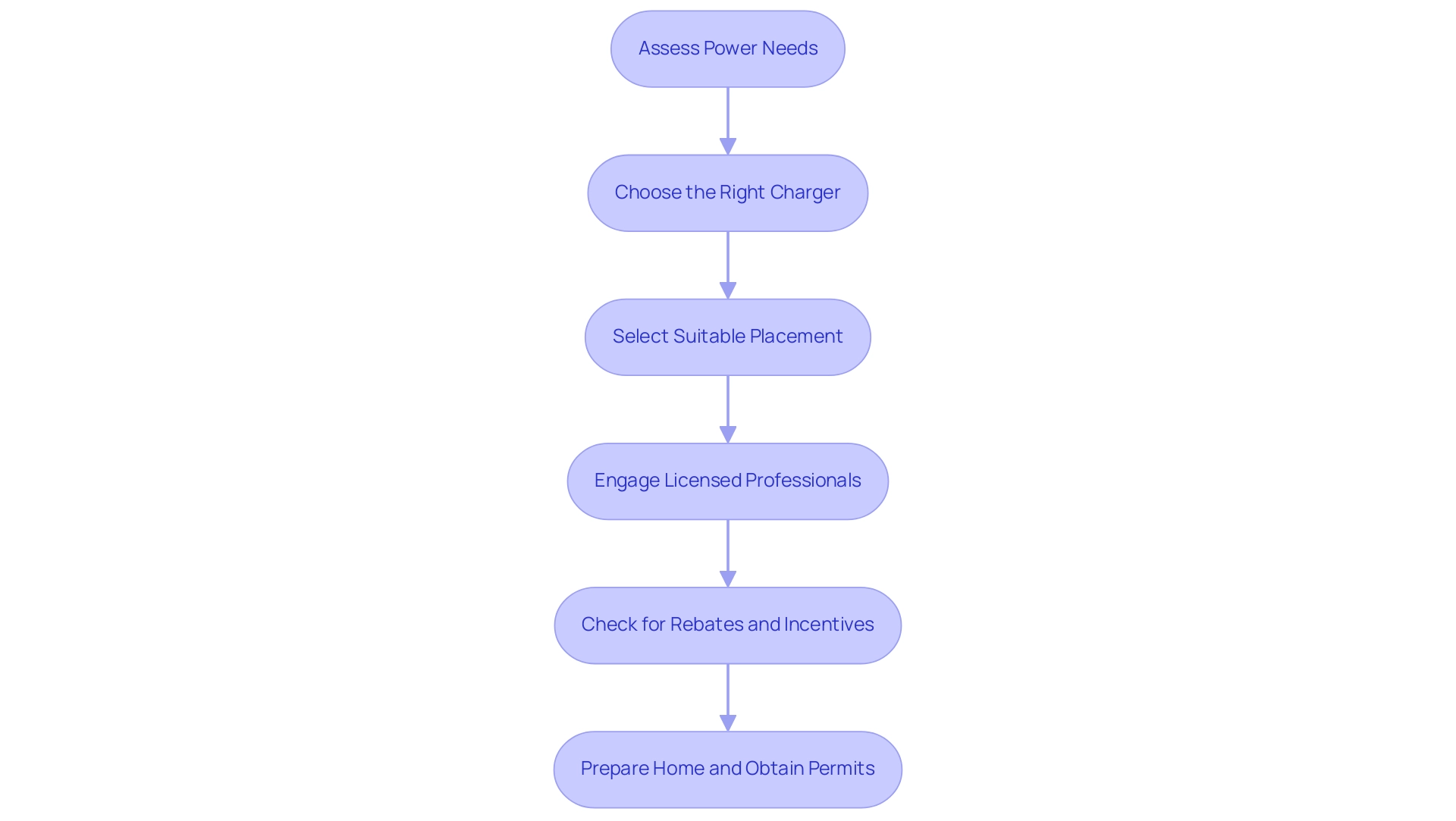Overview
To determine how much to install a Tesla charger, homeowners should consider factors such as the type of charger (Level 1 or Level 2), installation complexity, and potential rebates or incentives that can significantly offset costs. The article outlines that installation expenses typically range from $1,000 to $2,500 for a Level 2 charger and emphasizes the importance of evaluating personal power needs and engaging licensed professionals to ensure a safe and compliant setup.
Introduction
In the rapidly evolving landscape of electric vehicles, the choice of charging solutions has become a pivotal consideration for homeowners. Tesla offers two primary options—Level 1 and Level 2 chargers—each designed to cater to distinct charging needs and lifestyles.
- Level 1 chargers provide a convenient solution for overnight charging with modest range capabilities.
- Level 2 chargers present a significant upgrade, delivering faster charging times that can greatly benefit households with higher daily mileage or multiple electric vehicles.
As advancements in charging technology continue to emerge, understanding the nuances of these options, alongside the associated installation costs, incentives, and safety considerations, empowers homeowners to make informed decisions that align with their energy needs and sustainability goals.
Understanding Tesla Charger Types: Level 1 vs. Level 2
Tesla offers two main power supply options: Level 1 and Level 2 units, each designed for various requirements within the framework of contemporary energy solutions. Level 1 devices use a standard 120-volt outlet, making them a convenient option for overnight home power supply, typically providing about 3-5 miles of range per hour. However, this may be inadequate for households with multiple electric vehicles or those with substantial daily mileage.
In contrast, Level 2 devices operate on a 240-volt outlet, significantly improving power capabilities with delivery rates between 10 to 60 miles of range per hour, depending on the specific unit and vehicle model. A Level 2 charger at 22 kW can recharge an EV in approximately 1.8 hours, making it particularly advantageous for eco-conscious homeowners seeking efficient and rapid power solutions. Recent advancements in power replenishment technology have also introduced features such as media screens for entertainment and information during vehicle recharging, reflecting a broader trend towards improving user experience while supporting sustainability initiatives.
For example, the setup of a 20-port power station at the Phoenix Zoo by SRP emphasizes efforts to comprehend EV power usage habits. When choosing between Level 1 and Level 2 units, homeowners should take into account their lifestyle and power requirements, as well as how much to install a Tesla charger and any possible financial incentives from government programs, such as tax credits and rebates, which can assist in reducing setup expenses. It is also essential to consider how much to install a Tesla charger, since the pricing of Tesla home devices varies based on the type and installation requirements.
Additionally, exploring battery storage solutions can complement these charging options, enhancing energy efficiency. This comprehensive understanding of Tesla home devices and related solar energy solutions empowers homeowners to make informed decisions while also referencing related insights from posts like ‘Tesla Home Device Price’ and ‘How Homeowners Can Benefit from Government Solar Panels Program.
Evaluating Installation Costs for Tesla Chargers
The expenses related to setting up Tesla devices can vary depending on several factors, such as the particular kind of device chosen, the intricacy of the setup process, and regional labor rates. Homeowners should expect to spend between $1,000 to $2,500 for a Level 2 charger setup, which raises the question of how much to install a Tesla charger, as this cost includes the charger itself, labor fees, and any necessary electrical upgrades. Our team at Powercore Electric specializes in the installation of EV refueling stations, which involves several key steps:
- Site Evaluation: We perform a comprehensive evaluation of your property to identify the optimal site for the power station and examine any electrical needs.
- Electrical Upgrades (if necessary): Depending on the current electrical infrastructure, we may need to upgrade or modify it to support the station.
- Installation of the Station: Once the site assessment and electrical upgrades are complete, we install the EV station, ensuring it meets all safety and regulatory standards.
- Testing and Commissioning: We rigorously test the station to ensure it’s functioning optimally before handing it over to you.
Importantly, federal tax credits of up to $1,000, along with additional state and local incentives such as rebates for how much to install Tesla charger setups, can significantly offset these setup costs, promoting renewable energy adoption. Jordan, a Red Seal Master Electrician with more than 20 years of experience, recommends,
It’s essential to take into account the particular demands of your home and the power needs of your vehicle when preparing for setup.
To ensure competitive pricing and gain a comprehensive understanding of the entire project’s full scope, obtaining multiple quotes from licensed electricians is crucial.
Additionally, the warranty for a Wall Connector is 48 months for residential use, while the Mobile Connector has a 12-month warranty, providing peace of mind for homeowners. Considering that Qmerit has successfully set up over 450,000 EV power points across North America, utilizing their expertise can further assist homeowners in making informed choices regarding their power point setup. Additionally, comprehending personal driving behaviors is crucial for assessing the long-term expenses related to EV charging, as emphasized in the case study on long-term EV charging expenses.
Key Factors Affecting Tesla Charger Installation Costs
When contemplating how much to install a Tesla charger, several crucial elements can greatly affect the total expenses. Key considerations include:
-
Electrical Upgrades: If your home’s electrical system is not equipped to support a Level 2 device, upgrading your electrical panel becomes essential. This can range from $500 to $2,000, depending on the extent of the necessary renovations.
Notably, substantial electrical updates are often required due to the increased power demand of EV charging stations, which may include the installation of new transformers. With a Tesla Level 2 device, you can add 15 to 30 miles of range per hour, making these upgrades a valuable investment.
-
Distance from Electrical Panel: The location of the charger in relation to your electrical panel is crucial.
A longer distance requires additional wiring and labor, thereby increasing expenses related to setup.
-
Permitting and Inspections: Local regulations often mandate permits for setup, which can contribute additional expenses to your project. It’s essential to understand these requirements in advance to avoid unforeseen expenses.
-
Labor Rates: Hiring a certified electrician with expertise in EV installation, such as the professionals at Powercore Electric, may incur higher rates. Tom Grupa, an industry expert, notes that you can expect to spend around $150 for the first hour when hiring a master electrician, with average rates typically ranging from $100 to $120 per hour. Although this may seem steep, investing in a qualified professional is crucial to ensure safety and compliance with local codes.
According to a case study titled ‘Installation Considerations,’ it discusses how much to install a Tesla charger, which can range from $500 to $1,500, with possible extra expenses for distinct electrical panels and circuit breakers. Overall, understanding these factors will help you gauge how much to install a Tesla charger at your home. For expert assistance, consider reaching out to Powercore Electric at (916) 699-8778 or via email at ryan.serrano@powercoreinc.net.
Our experts in solar solutions and EV charging setups ensure a seamless and worry-free process tailored to your needs. As one satisfied customer, Jane D., noted, ‘We saved over 30% on our energy bills within the first year! Powercore’s team made the process easy and affordable.
The Importance of Professional Installation for Safety and Compliance
It is crucial to hire a qualified expert for the setup of your Tesla charger, particularly when you are considering how much to install a Tesla charger. Firstly, experienced electricians from Powercore Electric possess a deep understanding of local building codes and safety regulations, crucial for ensuring that your setup complies with all necessary standards. With a commitment to unmatched quality craftsmanship, our team guarantees that every setup meets the highest standards of safety and efficiency.
According to the Executive Director of Codes and Standards at NECA, Michael J. Johnston,
NECA supports the survey and outreach by ESFI to gather critical information related to ensuring that EVSE are safe when installed, and the electricians that install them remain safe while doing so.
This highlights the significance of professional oversight in the setup process. Secondly, incorrect setups can lead to significant electrical dangers, including the possibility of fires—about 15% of EV battery fires happen while the vehicle is plugged in.
The main reasons for these fires are frequently battery-related problems and charging faults, emphasizing the critical need for proper setup practices. Additionally, it’s important to consider the broader implications of electrical safety; for instance, children’s natural curiosity can lead to dangerous situations around electrical environments, as noted in the case study titled ‘Kids Safety.’ Lastly, numerous manufacturers, including Tesla, strongly recommend professional setup, especially regarding how much to install a Tesla charger, to safeguard warranty coverage.
By choosing Powercore Electric’s certified setup services, including electrical estimates and home safety inspections, you not only protect your investment but also achieve peace of mind, aware that your device is configured properly and securely, reducing the risks linked with electrical dangers. As one pleased customer observed,
‘Powercore Electric made the setup process seamless and stress-free, ensuring everything was done safely and efficiently.’
Choose Powercore Electric for a customer-first approach and sustainable energy solutions that benefit both your home and the environment.
Exploring Rebates and Incentives for Tesla Charger Installations
Homeowners seeking to set up a Tesla charging station often wonder how much to install a Tesla charger, and they can significantly gain from various rebates and incentives aimed at reducing the financial strain of setup. The typical expense for a Tesla Level 2 home device usually varies from $1,200 to $2,500, which is relevant when considering how much to install a Tesla charger based on the difficulty of the setup and regional labor fees. Homeowners can balance these expenses through different programs that differ by state and utility provider, with many providing significant cash rebates or tax incentives for EV charging setups.
For instance, California inhabitants can utilize the California Electric Vehicle Infrastructure Project (CALeVIP), which offers substantial rebates for Level 2 charger installations, greatly lowering initial expenses. Pennsylvania offers a rebate of $3,000 to $4,000 for new or certain used electric vehicles with a purchase price of $50,000 or lower, further incentivizing EV adoption. Additionally, federal tax credits may apply for EV charging equipment, providing another layer of potential savings.
Tesla’s program for managing Solar Renewable Energy Credits (SRECs) generated by solar systems can enhance financial benefits for homeowners, making it even more appealing. Qmerit, an electrification ally, highlights that the savings from embracing clean, sustainable energy are merely the start of the advantages homeowners will encounter. It’s essential to consult local utility providers and government resources to uncover any available incentives that can help reduce costs, particularly regarding how much to install a Tesla charger.
Furthermore, states like New York have implemented comprehensive programs encouraging electric vehicle ownership through various incentives, such as tax credits and exemptions from emissions testing, which not only enhance individual savings but also contribute to broader environmental benefits. Additionally, Black Hills Energy offers residential energy customers up to a $5,500 rebate towards a new or used electric vehicle, highlighting the diverse incentives available across different regions. In Southern California, homeowners should also investigate local utility programs that may offer additional rebates or incentives for installing EV stations, further enhancing the affordability of going electric.
Preparing for Your Tesla Charger Installation: A Step-by-Step Guide
Preparing for your Tesla charging station installation involves several key steps to understand how much to install Tesla charger for an efficient and effective setup. Start by assessing your power needs: evaluate your driving habits to determine how frequently you use your vehicle and the speed at which you require it to be replenished. Next, choose the right charger; based on your charging frequency, decide between a Level 1 charger, which is suitable for overnight charging, and a Level 2 charger for quicker replenishment.
It’s also crucial to choose a suitable placement—ideally, this should be near your parking area and close to your electrical panel for ease of access and lower expenses.
For instance, a simple outlet setup can cost around $10, while a wall connector setup may run into the hundreds, which raises the question of how much to install a Tesla charger and emphasizes the importance of planning your setup carefully. Engaging licensed professionals is crucial; Powercore Electric specializes in this area, ensuring a thorough site assessment to determine the best location and any necessary electrical upgrades. Our team also ensures that all setups meet safety and regulatory standards to guarantee optimal performance and safety.
As mentioned by industry expert Beerman81, misconceptions regarding wire ratings, such as the notion that wire rated at 60A is undersized, can result in suboptimal setups. In reality, when installed correctly, this wire can be suitable for modern EV chargers, highlighting the need for professional guidance.
Furthermore, insights from the case study titled ‘Choosing the Right Power Supply for EV Charging’ suggest that selecting a suitable power supply involves considering factors such as amperage rating and setup requirements, which can significantly enhance efficiency and user experience. Furthermore, take time to check for available rebates and incentives in your area that could help offset setup costs, and Powercore Electric can assist you in identifying and applying for these programs, making the transition to electric vehicle ownership more affordable. Lastly, prepare your home by ensuring that your electrical panel is accessible and that you have obtained any necessary permits beforehand.
By following these steps and engaging with our professional team, you’ll set the stage for a successful Tesla charger installation and learn how much to install a Tesla charger, enhancing both convenience and efficiency.
Conclusion
Understanding the differences between Tesla’s Level 1 and Level 2 chargers is crucial for homeowners navigating the electric vehicle landscape. Level 1 chargers offer a convenient solution for those with lower daily mileage or single vehicles, while Level 2 chargers cater to households with greater energy demands, delivering faster charging solutions that significantly enhance usability. As the technology evolves, the choice between these options becomes increasingly aligned with individual lifestyles, energy needs, and the potential for cost savings through incentives.
Installation costs for Tesla chargers can vary widely based on factors like electrical upgrades, labor rates, and the complexity of the setup. Engaging qualified professionals for installation not only ensures compliance with safety standards but also protects the investment with proper warranties and peace of mind. The potential financial incentives available, such as tax credits and state-specific rebates, further bolster the case for making an informed decision about the right charging solution.
Ultimately, the path to adopting electric vehicle technology is paved with considerations that go beyond just the charger itself. By evaluating personal charging habits, understanding the specifics of installation requirements, and leveraging available incentives, homeowners can make empowered choices that align with their sustainability goals. Embracing these advancements in charging technology not only enhances daily convenience but also contributes to a broader commitment to renewable energy and environmental responsibility.



